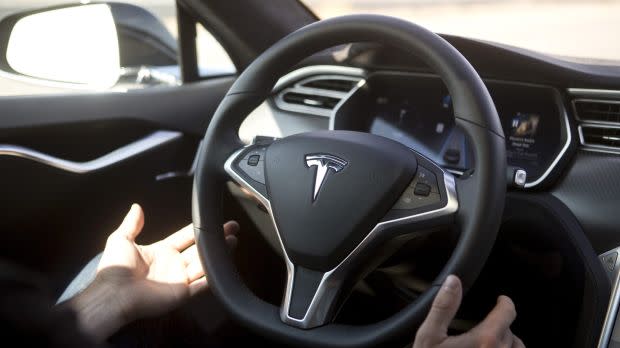Tesla’s new insurance uses real-time car data to decide the likelihood of an owner crashing

Tesla’s new insurance product—based on “real-time driving behavior“—could help drivers save money, the company claims.
To calculate the premium, the electric car maker will rely on a driver’s “safety score,” via the Full Self-Driving (FSD) Beta version released in September, which takes into account braking, turning, tailgating, forward collision warnings, and forced autopilot disengagements to predict the probability of a collision.
The cars collect “enormous amounts of data to assess the attributes of drivers and whether those attributes correlate with safety,” chief financial officer Zachary Kirkhorn explained during an Oct. 20 earnings call. “Tesla has used this driving history data to create the model that’s able to predict the probability of a collision over a period of time.
Already, with the anonymized, aggregated data it has been using to offer insurance for the last couple of years, Tesla claims to generate savings of between 20% and 30% compared to traditional insurers. Using more data could cut down the price even more.
Tesla’s dynamic insurance premium
Insurance companies typically calculate premiums based on accident history, or demographic markers such as marital status and age, among other things. It is inexact and impersonal; consequently, low-risk customers often end up overpaying, and riskier customers may in turn enjoy subsidies.
“As we looked at this and we looked at the data, we thought this just doesn’t seem like it’s fair,” Kirkhorn said.
The idea is that by studying real-time data from its cars—that are essentially computers-on-wheels, Tesla says—the company claims it can offer individualized pricing that’s “integrated into the car, integrated into the app, integrated into that customer’s experience.” There’s also a feedback loop that tells a driver what adjustments they can make to improve their safety. Not only does the way you drive affect your premium, Tesla says, but the car can also improve your driving.
Nearly 150,000 Tesla cars are already using the “safety score” feature. So far, the firm has analyzed over 100 million miles of driving data and found that the probability of a collision for a customer using a safety score versus someone who is not, is 30% lower. (The company only supplies an approximate percentage, not the underlying data.)
Earlier this month, Tesla began rolling out the safety score-based insurance in its new home state, Texas. It’s also looking to introduce it in California and other states, if regulators approve.
Are you really saving money on a Tesla?
“Our customers were coming to us complaining that the price of traditional insurance was too high. And it was reducing the affordability of a Tesla,” CFO Kirkhorn said. “If we can get $5, $10, $20, $30 out on a monthly payment, you can calculate what that means in terms of reduction of the price of the car if you finance it, and the leverage of improving insurance cost is huge in terms of affordability.”
However, the safety score is only available to those who purchase the FSD software, a system that will one day offer full autonomous driving capabilities, according to CEO Elon Musk. That costs an additional $10,000.
This system of insuring is a double-edge sword. The same feature that would save a driver money could end up costing them more, too. The insurance premium may change month-to-month because of factors a driver cannot control—think unfavorable weather or tricky terrain. Moreover, the algorithm is apparently extremely sensitive, with people claiming their score dropped several percentage points even when they’ve been braking softly or turning cautiously.
The number alone is devoid of context, which means good drivers could be unfairly penalized or bad drivers could cheat the system. And while insurance does tend to be a big burden on car owners in the US—especially electric car owners—Teslas are not the cheapest option in the market to begin with. Prices are steep, and they only keep going up.
Sign up for the Quartz Daily Brief, our free daily newsletter with the world’s most important and interesting news.
More stories from Quartz:
An uproar over a Fabindia commercial highlights the challenges facing Indian brands
The Chappelle controversy is a test of what kind of workplace Netflix wants to be
